![]()
Return to Index/Main Page
| A lexicon of knife terminology: Section B | ||||||||||||||||||||||||||
| Numbers | A | B | C | D | E | F | G | H | I | J | K | L | M | N | O | P | Q | R | S | T | U | V | W | X | Y | Z |
B&T: See Bird & Trout Knife
Baby Copperhead: 1) 1) A version of the standard copperhead knife that is under three inches when closed.
2) Another name applied to the Case Mini-Copperhead, especially when made by another manufacturer. See Mini-Copperhead.
Back Pocket Knife: Typically a large frame (4.5 inches or greater, closed) single blade knife with a thin profile. Popular patterns include single blade trappers, cokebottle and folding hunters. Back pocket knives may be slipjoints or lock-blades.
Bail: A small ring on the end of folding knife used for the attachment of a lanyard or key ring. Britons and the Commonwealth refer to the bail as a shackle.
Bait Knife:A utility fixed blade knife used for cutting bait and other fishing chores small enough to fit in a tackle box. While Bait Knives have been around for a long time the term is relatively recent, at least from a market perspective. The blade is thicker and lacks the flexibility of a fillet knife and often has a serrated spine suitable for scaling fish.
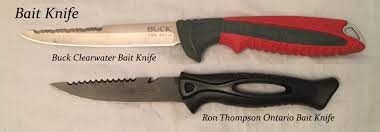
Balisong: A knife that has two separate handle sections in which each section covers one side of the blade when closed. With a flipping motion the handle section can pivot around to form a grip and expose the blade for use. Believed to have been brought to the Philippines by English sailors, the knives are extremely popular there and have become popular in the US until have import restrictions were placed on them due to their potential and popularity as a self-defense weapon. They are illegal to carry in many large metropolitan areas

Bamboo: A material used for scales, handles and scabbards. Stabilized bamboo is becoming popular due it being a sustainable source of material.
Band Saw Steel: A tough type of tool steel used in the production of band saws and also by custom knife makers. ASTM standards refer to it as L-6 steel (it also called 15N20) Band Saw steel is often used along with 1095 Steel for the production of Damascus or pattern welded steel
Barlow: A very old traditional pattern folding knife with handles shaped like elongated tear drops, with a large bolster on the tang end and no bolster on the butt or cap end (Bare end). The bolster is normally 1/3 the length of the knife. Most Barlows have two blades, a large clip and a pen blade. The blades are always attached at the top end of the knife and normally have their own channel. The standard size is around 3.5 inches but it varies slightly from maker to maker. (see also Grand Daddy Barlow)
Barn Door Jig: A type of cutting used a knife handles in which the cuts run parallel to the direction of the knife handle.
Bartender’s Knife: A traditional pattern folding knife; a type of utility knife that normally has a large spear point blade, a label cutting blade, a cap lifter and a cork screw. These are slowing becoming a thing of the past, being replaced by the bartender’s tool.
Bartender’s tool: The bartender’s tool consists of a handle with a folding cap lifter on one end and small pen blade on the other. In the middle is a large cork screw. While similar to the bartender’s knife the tool dispenses with the large main blade and has a cap lifter made U-shaped piece of steel that wraps around one end of the handle instead of an actual blade. This u-shaped peice of steel is actually a fulcrum that is placed on on the lip of wine bottle and aids in the removal of the cork.
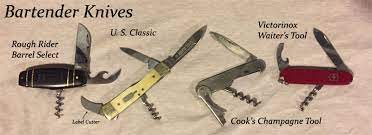
Baton, Batoning: A wooden dowel or club that is suitable for striking the spine of a knife. Batoning is the act of striking the spine of a knife with a heavy piece of wood fro the purpose of using the knife blade as a wedge to split wood.
Bayonet: A thrusting type of knife specifically designed to be attached to the barrel end of a rifle or other firearm. The two most prominent features of a bayonet are the barrel catch and the barrel ring. However, collectors should be advised that not all bayonets feature a catch or ring.

Bayonet grind: A slender double edged spear point blade in which only the last 1/3 of the spine has been shaprened to improve the trusting ability of the blade. The remaining spine lacks an edge which improves the overall strength of the blade. The blade style is found on the American M3 Trench Knife and M4-M7 bayonets as well as other post WWII bayonets on Western Nations.

Bear MGC: The economy line of knifes marketed by Bear & Son. They are made in the United States. They began making the knives for the Boy Scouts of America in 2009.
Bear & Son Cutlery: An American knife making company located in Jacksonville, Alabama that makes all their products in house, not relying on distributors for parts.
Bolster: A metal cap found on the ends of folding knives. They are normally made of nickel-silver but can be made of other metals.
Belly: The side opposite the spine; the cutting edge of the blade. Not to be confused with the point of the blade used for poking.
Benchmade: An American Cutlery company located in Beaver Creek Oregon. They specialize in Tactical and Rescue style knives. Their products are currently made in the US but their old Red Class line was made “off shore.” Benchmade also markets HK (Heckler & Koch) and HD (Harley Davidson) knife brands.
Bird Hook / Bird Hunter Knife A folding knife normally built ona traditional pattern frame such as a Trapper, Muskrat, Stockman, etc. The knife will have a long hook for one blade which is inserted into the birds cloaca or vent in order to grab the intestines and pull them out. The knife is normally used for cleaning pheasants and other small game birds.
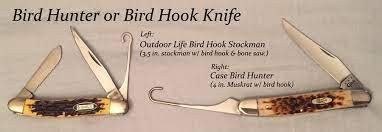
Bird & Trout A small game knife used for processing birds and fish. Today a number of knives are used for this task. Among collectors, the traditonal bird & trout knife is approximately 6.5 inches (16.5 cm) long with a slender clip blade making up half the length. It is one of the more popular knives among collectors due to its small size.
Modern bird & trout knives normally have a wider blade and larger handle. The blade length normally remains around 3 inches (7.6 cm) but the handle is a more ergonomic 4 inches(10cm) or more.
The tradional folding toothpick was marketed as a folding bird & trout. Like the bird & trout, the toothpick has a long slender blade but often has a more substantial handle. As it folds it does not need a sheath and takes up less room.
The bird & trout knife has been given numerous other names both by manufacturers and users. Thus, it is popularly called B&T, Beak & Gill, Fish & Fowl, Fin & Feather, etc. The Traditonal B&T is sometimes called a Pheasant Knife The Canadian Belt knife is also known as a Trout & Bird Belt Knife. See also Bait Knife and Small Game Hunter.

Blackjack: Hand crafted high-end USA made knives. The trademark is currently owned by SMKW but the original company and its owner still make the knives. They primarily make fixed blade knives. SMKW also markets less expensive globally made knives under the Blackjack trademark
Black Jet: See Jet Stone
Black Pearl: More appropriate called Black Lip Mother of Pearl. Pearl derived from black lip oysters (Pinctada margaritifera).
Black Wood: Any wood that is black in color or in some cases wood that has been dyed black, with the exception of ebony. If the knife actually has ebony handles they seller will say so. (See Ebony)
Blade Properties: The properties that make up the qualities of good blade. These include: Hardness (Strength & Toughness), Edge Formation, Wear Resistance (Edge Retention) and Stain Resistance.
Blade Stamp: A mark stamped into knife’s blade in a location other than the tang. This is normally information concerning blade quality, company or country of origin. (See also tang stamp.)
Bloodgutter or Bloodgroove: (See: Fuller)
Bloodstone: Bloodstone is green jasper with bright red spots or veins caused by the presence of iron oxide It was treasured in ancient times and served for a long time as the birthstone for March. This attractive chalcedony quartz is also known as heliotrope
Bloody Basin Jasper: Bloody Basin Jasper is a Red jasper with dark red, brown, green or black flecks appearing in it.In many ways it appears to be just the opposite of bloodstone, another type of jasper Bloody Basin Jasper is also called Bloody Red Jasper or Red Jasper It is found in the Bloody Basin located in Arizona, hence the name.
Blue Ridge Cutlery: An American knife wholesaler associated with Smokey Mountain Knife Works (SMKW).
Boater: See Rigger’s Knife, definition number 2
Bolo: A bolo is Filipino kniife a kin to the machete, used particularly in the jungles of Indonesia, the Philippines, and in the sugar fields of Cuba. Like Machetes, bolos were often hand made in a variety of locations, the size and shapes of the blades vary tremendously. Bolos are work knives used to clear vegetation for agriculture or cutting trails . It is called an iták or sundáng in Tagalog, the langauge of the Filipinos. The bolo became legnedary during the Philippine revolt in 1898 and the Philippine-American War which followed. It's legend and popularity grew during WWII when US military personnel (Army, Navy and Marines) serving in the Pacific were provided bolos for combat duty.
Boot-Knife: Normally a small fixed blade knife that is meant to be concealed in a boot or in an ankle scabbard. The term is some-what generic in that it describes how a knife is worn on the body and not necessarily any particular style of knife. However, it most often refers to a small concealable dagger used for personal defense.

Böker: An older German cutlery company that currently has its knives manufactured in Germany, Argentina, China and Taiwan. For the most part Böker Plus knives are made in China or Taiwan.
Bolster: A metal cap, normallt made of nickel silver or stainless steel, that is located at one or both ends of a folding knife’s handle.
Bone: A versatile handle material used especially in traditional pattern knives. Bone normally refers to actual bone normally from domesticicated cattle as part of the by-product of the meat industry. In the United States, this normally refers to domestic (American) cattle bone. Bone scales used on Case brand knives normally comes from Brazilian Zebu cattle stock. Bone can be smooth or jigged (cut) in a variety of patterns. It is often dyed. While very hard and prone chipping and cracking, it is also relatively light weight, does not shrink and is very durable.
Bottle Opener: Same as cap lifter:
Bowie: Pronounced “Boo-ee” not “Bōw-ee” Named after American frontiersman Jim Bowie.
Any large fix blade knife, normally with a full cross guard. There is much debate on the design of the original Bowie knife made for Jim Bowie including the size of the knife and if it even had a cross guard.
2The Classic or Western Bowie is a large clip blade knife often with a blade measuring nine or more inches. It will normally have a full tang and an “S” shaped quillion or gurad. The spine of the blade is sometimes stiffened with a brass plate. This is probably the most defined of the Bowie knives and is what many people envision when they hear Bowie knife, however it cannot be traced back to Jim Bowie's Iron Lady. ' Most historians beleive the Western Bowie is more likely patterned afer English made Bowies for sale in America.
Today, many people divide Bowies in small or large with a seven inch blade being the normal tipping point. Others consider the 7 inch clip blade a medium Bowie. Like many fixed blade patterns, even the iconic Bowie knife is open to interpretation. (See hunter, skinner, and toothpick for comparison.)

Boy Scout Knife: A term often applied to the four blade camp knife as this was the pattern Officially adopted by the Boy Scouts of American as their No. 2 Pocket knife in 1910. Among collectors the term usually is reserved for any knife that bears an Official Boys Scouts of America stamp or marking. The Boy Scouts of America have partenered with numerous knife makers and produced a variety of official knives, including fixed blades. See also Scout, Camp, and Utility for comparison.

Boye Dendritic Cobalt (BDC) A non-steel alloy used in knife making. It is wear and corrosion resistant.
Browning: One of many gun makers turned knife maker in the 1960s. Originally Browning turned out high-end knives on par with Gerber. Eventually manufacturing moved overseas and quality faltered. Today they produce both economy and mid range folding and fixed blade knives similar in quality to Buck.
Buck: A knife made by Buck Knives, a family owned American enterprise. Buck Knives is located in Post Falls, Idaho and is credited with the introduction of the folding hunter. Their economy line of knives were made in China and use a different quality of steel. Their mid-range and high end knives are made in the United States.
Buck 110: Buck's version of the LB-5 or Five Inch Lock-back. While Buck made the pattern very popular other companies also made the knife and it has sinced been copied by several companies and is often a target of no name copy-cats. The pattern is very popular among knife customizers. Unfortunatly for the Buck Trademark, any knife looking like a Buck 110 is often called a Buck knife buy the unsuspecting.
Budding (Budding & Grafting) knife : A horticulture knife with specialty blade used for lifting bark, and grafting branches . The blade is normally a cotton sampler style blade with an added bark lifter on the end of the spine. . See Garden knife or Horticulture knife for related knives.
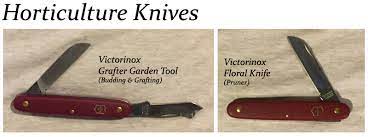
Buffalo Bone: Normally, bone derived from DomesticWater Buffalo used for handle material. Domestic Water Buffalo are common through-out Asia Buffalo Bone is a common feature on knives made in Pakistan and/or India but is also featured on high-end knives.
Buffalo Horn: Normally, horn derived from DomesticWater Buffalo used for handle material. Domestic Water Buffalo are common through-out Asia The horn is a common feature on knives made in Pakistan and/or India but is also featured on high-end knives.
Burl Wood: A favorite type of wood used in knife handles. Burl wood is a type of fast growing, abnormal growth found on some trees. Burl wood grows because the tree has experienced some sort of environmental stress or damage. This is often caused by either a fungal attack or an attack by insects. It can also be created with manmade interference.
Bushcraft: Wilderness or survival skills, especially those involving making shelter, traps, and fire.
Bushcraft Knife: A somewhat generic term refering to knives used in the art of Bushcrafting. The definition will differ from person to person, especially when it comes to size. In general a good bushcraft knife will be a full tang fixed blade knife with a comfortable handle, a sturdy blade with a thick spine that is suitable for battoning. A flat grind is often preferred. A lanyard hole is also preferred. See Survival Knife and Camp Knife for Comparison.
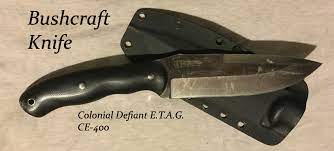
Butcher Knife: Normally, a large kitchen utility knife used for butchering meat. The size may vary. The butcher knife with a seven or eight inch blade is common form most household kitchens. However, larger ones are often found in the restaurant and meat packing industry are often larger. A butcher knife is used for cutting large portions of meat and normally has a thicker blade than a chef's knife. While the blade shape varies, most western Butcher knives are modeled after earlier Sheffield Butcher knives and a feature a clip blade. As the butcher knife like most kitchen knives is not seen as a fighting knife it normally does not possess guard. Compare to Chef's Knife, Cleaver, and Boning Knife, Bowie Knife.

Butter Knife / Butter Spreader: In its purist form the Butter knife is a dinner or table knife that accompanies the butter dish in a dinner setting. The butter knife normally has a clip point and a dull edge. It will often have an offset handle to aid its use as a spatula. It is used to remove tabs of butter from the communal butter dish to the dinner plates and is not meant to be used to spread butter. The reason it is not used by diners to spread butter is to prevent cross contamination of the butter.
The butter spreader is a knife often misidentified as a butter knife. The butter spreader is part of the individual place settings at the dining table. The butter spreader normally has a rounded or blunt tip and is sometimes semi sharpened or has serrations to aid in cutting prepared food or cutting bread. The knife is called a spreader as it the tool used to spread butter on bread.
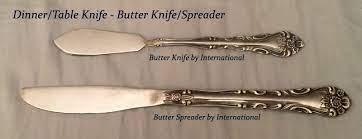
Butterbean: A traditional pattern folding knife; a small canoe pattern knife less than three inches in length, normally 2 5/8 inches.
Butterfly: see Balisong
Buzzsaw Trapper: A trapper style knife where the secondary blade is a saw blade. Also called a buzz saw trapper or saw blade trapper. (See Trapper for fuller description.)
Byrd: An Economy line of knives offered by Spyderco. They are made in various Asian nations. Byrds use a "bird's eye" thumb hole compared to the circl thumb hole used on Spydercos. They also have lower priced, lower quality blade steel and/or handle material but are still considered quality knives.
Return to Index/Main Page